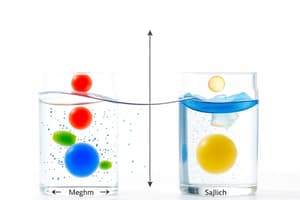Podcast
Questions and Answers
What is the normal pH level of blood?
What is the normal pH level of blood?
- 8.0
- 6.8
- 7.4 (correct)
- 7.0
Which substance is primarily involved in the buffering of blood pH along with bicarbonate?
Which substance is primarily involved in the buffering of blood pH along with bicarbonate?
- Calcium
- Sodium
- Amphoteric proteins (correct)
- Chloride
What is the predominant intracellular buffer in the body?
What is the predominant intracellular buffer in the body?
- Proteins
- Carbon dioxide
- Phosphate (correct)
- Bicarbonate
Which condition is associated with fruity breath due to metabolic changes?
Which condition is associated with fruity breath due to metabolic changes?
Which ion is primarily involved in acid-base balance and buffering within extracellular fluid?
Which ion is primarily involved in acid-base balance and buffering within extracellular fluid?
What role do phosphate ions play in the body?
What role do phosphate ions play in the body?
Which of the following substances is described as having an amphoteric nature?
Which of the following substances is described as having an amphoteric nature?
In the context of acid-base balance, what is a significant characteristic of bicarbonate?
In the context of acid-base balance, what is a significant characteristic of bicarbonate?
What symptom is associated with diabetic ketoacidosis due to metabolic changes?
What symptom is associated with diabetic ketoacidosis due to metabolic changes?
Which of the following statements about buffers is true?
Which of the following statements about buffers is true?
Flashcards
Blood pH
Blood pH
The measure of acidity or alkalinity in blood, normally 7.4.
Buffers in blood
Buffers in blood
Substances that help maintain a stable pH in blood, like phosphate and bicarbonate.
Bicarbonate and Phosphate
Bicarbonate and Phosphate
Important blood buffers that help maintain constant blood pH.
Acid-Base Imbalance
Acid-Base Imbalance
Signup and view all the flashcards
Diabetic Ketoacidosis
Diabetic Ketoacidosis
Signup and view all the flashcards
Buffer System
Buffer System
Signup and view all the flashcards
Bicarbonate Buffer
Bicarbonate Buffer
Signup and view all the flashcards
Phosphate Buffer
Phosphate Buffer
Signup and view all the flashcards
Acidosis
Acidosis
Signup and view all the flashcards
Study Notes
Blood pH
- Normal blood pH range is 7.35-7.45
- Blood pH is maintained within a narrow range due to cell functions being pH-sensitive
- Enzymes, receptors, ion channels, and transporters are all pH-sensitive
- Acidosis occurs when plasma levels fall below 7.35
- Alkalosis occurs when plasma levels rise above 7.45
- These imbalances affect all body systems, leading to potential complications like coma, cardiac failure, and circulatory collapse
- Acidity measured by H+ concentration
- Normal pH 7.4
Acid-Base Balance
- The normal pH of systemic arterial blood is 7.35-7.45 is maintained through
- Homeostasis maintained by:
- Buffer systems (proteins, carbonic acid-bicarbonate buffers, phosphates)
- Respiration (exhalation of CO2)
- Kidney (excretion of H+ and reabsorption of HCO3-)
Buffers
- Chemical buffers react within fractions of a second
- Examples of chemical buffers include
- Bicarbonate buffer system
- Phosphate buffer system
- Protein buffer system
- Physiological buffers (respiratory and urinary systems) react over hours to days.
The Respiratory System
- Adjusts pH by regulating CO2 levels
- High pH (alkalosis): faster breathing to remove CO2
- Low pH (acidosis): slower breathing to retain CO2
The Kidney
- Reacts over hours to days
- Excretes excess H+ or retains bicarbonate depending on pH
- Reabsorption and secretion of bicarbonate
- Secretion of H+ maintaining pH by acidifying urine.
Acid-Base Disorders
- Changes in arterial PCO2, serum HCO3-, and serum pH
- Categories:
- Respiratory acidosis
- Respiratory alkalosis
- Metabolic acidosis
- Metabolic alkalosis
Specific Acid-Base Disorders
- Respiratory Acidosis: Hypoventilation (slow or shallow breathing)
- Respiratory Alkalosis: Hyperventilation (rapid or deep breathing)
- Metabolic Acidosis: Excess acid or loss of bicarbonate
- Metabolic Alkalosis: Loss of acid or excess of bicarbonate
Effects of Acidosis
- H+ diffuses into cells, displacing K+, leading to hyperkalemia
- Depresses the central nervous system causing confusion, disorientation, and eventually coma
Effects of Alkalosis
- H+ diffuses out of cells, K+ enters cells, leading to hypokalemia
- Nervous system is hyperexcitable leading to muscle spasms, tetany, convulsions, and ultimately, respiratory paralysis
Studying That Suits You
Use AI to generate personalized quizzes and flashcards to suit your learning preferences.




